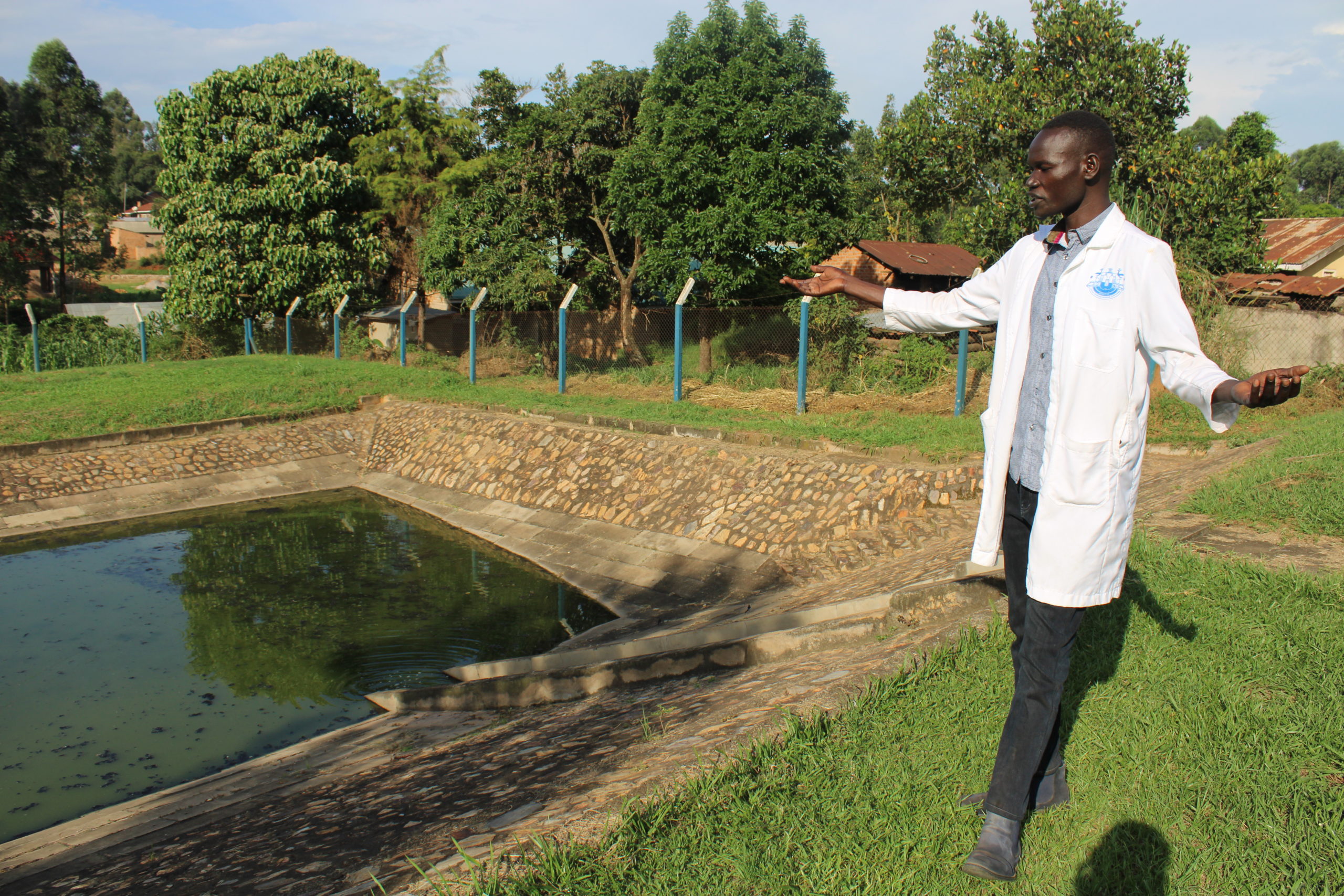Hoima is a city bustling with activity, having neatly paved roads, storeyed buildings and gentrification due to treasurer hunters attracted by speculation of opportunities presented by oil finds in the Albertine Graben.
However, the city’s glitter is increasingly being dampened by the stinking environs, especially behind Wright Road, Main Streets, Kiganda and Kiryatete suburbs where business owners wear a permanent frown about the poor state of the overflowing sewage out of the lines.
At Hoima central market, human excrement pours uncontrollably into the streets and sometimes when it rains, it ends up polluting the streams and rivers.
Experts warn that this poor state of waste management presents imminent dangers of waterborne diseases and pollution of the ecosystem.
City officials complain of lack of finances to expand the infrastructure to match with the growing population.
The city has an old single but open cemented sewage line that starts from Hoima Taxi Park and pours wastewater in rivers and streams below.
There is also a sewage lagoon in Kiganda cell that was constructed on a hilly area that is constantly releasing green sewerage water into the river below it.
National Water and Sewerage Corporation (NWSC) maintains that lagoon waste is usually collected and treated and then released into the wetlands when they are sure that there is no harm it can pose to the community and the ecosystem.
However, a March 28, 2012 report by the government analytical laboratories study on water sources, indicated that water sources below the said lagoon in the neighbouring areas were found contaminated.
The report added that fecal matter from the facility makes water below it unsafe for human consumption and residents were advised to stick to piped water.
Hoima supplies 3 million litres per day, which is 70% of the present demand, leaving a gap of 30%.
The NWSC report shows that only 6,497 of the estimated 20,000 homesteads are connected to piped water within the city.
Hoima, which was elevated from a municipality to a city status in July 2019, wastewater comes from schools, hotels, restaurants, businesses and homesteads.
Few rich people are connected to the sewage system as the city lacks short-term measures before the situation turns into a crisis.
Bosco Muhanuzi, the East Division Chairperson which covers much of the central business district told The Albertine Journal on May 15 that the sewage system that was designed for a town council in the 1990s has never been upgraded.
Muhanuzi has asked the government to increase budgetary allocation to expand the sewage infrastructure, which currently covers only 4 kilometres of a city. The City covers 228 square kilometres with a road network of 600 kilometres.
In the past, there was not much sewage being generated and only storm water would flow freely to the rivers and streams or wetlands.
Today as the population has increased, construction pressure has generated much solid waste that also clogs the drainage line and people just pour sewage to be swept by running rain water.
Hoima City has a population growth rate of 10.7% coming second to Wakiso town with 11.9%.
Moses Semahunge, an environmentalist, said when waste discharges are connected to the wetlands directly, they would deposit a lot of fecal matter, urine into the rivers and this will cause high fertilisation in these rivers, and there will be eutrophication.
The result is that there will be algae produced on top of these rivers and this will inhibit free oxygen supply and in the end jeopardise aquatic life.
Semahunge, who also doubles as the Project Manager for Bulindi Chimpanzee and Community Project, said besides, these fecal materials come along with so many disadvantages especially health wise.
There will be transmission of waterborne diseases such as cholera, this will greatly affect the population in terms of health and a lot of money will be used to treat diseases caused by reckless discharge of wastewater into the wetlands.
He said because the sewage system is not upgraded, there is more sewage flowing on the roads causing bad smell wafting through the air.
Effect on water
The water volumes of many rivers and streams have reduced already or dried and some have been encroached on by settlers, cultivators and car-washers.
So, the wetland acreage in the city has greatly reduced. Semahunge said that if it continues at this pace, Hoima may not have wetlands in the next twenty years.
Semahunge says although there is a law in place to punish culprits, this has not been enforced due to lack of a multi-stakeholder will to stop this.
“Chemicals from spills like oils as a result of the area racing to produce oil, more harmful wastes will be poured into the rivers if caution is not taken. We are going to see all vegetation in wetlands polluted and dry up. We need a robust waste management system if wetlands are to be protected,” he said.
Contamination raises the cost of residents’ access to clean water and the cost of water treatment.
Already, city dwellers trek long distances in search of clean water since few people are connected on piped water that covers areas mainly in the heart of the city, leaving some unemployed and urban poor still fetching from contaminated sources.
Joseph Kiiza, a resident and a car-washer at Bigajuka stream in Kiganda cell, said all the water in town is contaminated and yet clean water must be clear and colourless.
Kiiza told The Albertine Journal that a quick gaze at the water in city streams is either milky, greenish or reddish due to waste disposal of degradable, non-degradable and toxic substances and debris.
He added that when wastewater which is usually black in colour is released by businesses-hotels, restaurants and homesteads into the waters where they work, their work gets to a halt.“We cannot wash cars with contaminated and unclean water until it clears after flowing,” he said.
“National Environment Management Authority needs to come out strongly and apprehend these polluters because if they don’t do it they give room to more polluters to do the same,” Kiiza asserted.
He said although they are aware of the dangers of their activities on the ecosystem, he is quick to add that increased degradation of these resources by toxic wastewater one time will not know who participated or not but they will universally harm everybody.
Other experts also aver that there is inadequate sensitisation of the public, unplanned structures, poor enforcement of environment protection laws and negative mindset.
Denis Otto, NWSC quality control officer for Hoima City, however dispelled the myths that they do not treat wastewater before discharge.
“You can see a colour change at the inlet and outlet. This is an indication that there is treatment ongoing. The presence of the greenish top layer of the sewage shows that there is a treatment ongoing because the complex organic that had entered into the sewer has been broken down and is supporting the growth of the plant towards the end,” he said as he led The Albertine Journal around the sewage lagoon in Kiganda cell.
Otto said to release waste they have to first ensure that the receiving environment is able to contain and if not green, it makes them to design on what is prudent and take the samples for analysis in the laboratory.
Fredrick Byenume, a public health expert, said sanitation in the City is not to standard because the sewage lines are blocked and the sewage plant (lagoon) was poorly done.
“It was supposed to have chambers but it is like a swimming pool. It was supposed to have three sections but has one, and it is not effective and that is why you feel a foul stench emanating from there,” he said.
Tom Mbazira, NWSC Hoima area manager, who admits that although they have improved on the piped water extension part they are a bit constrained on the sewage.
He said now they are procuring a consultant (names withheld) to do a feasibility study and design for the improvement of water supply and sanitation.

NWSC’s Mbazira. Photo: Robert Atuhairwe/The Albertine Journal.
He disclosed that the lagoon is supposed to be relocated outside the city and they hope before the end of July the consultant should be on the ground taking on the studies to plan for the sewage.
“Connections are limited due to low coverage, if the coverage was big, more people would have taken on the services. Most people discharge into open drains which pollute streams.”
However, he said going forward the city authority should also come up and monitor to ensure there is no open disposal to save the environment.
“We are coordinating with city authorities to ensure most customers are connected on the grid. Drainage channels are always smelling implying there is illegal disposal which poses an environmental and health threat to the people.”
Junior Ampumuza, an environmentalist in Hoima City, agrees that Hoima needs to invest in infrastructure to manage sewage with more emphasis on wastewater treatment for reuse to also address water scarcity for dwellers.
But Otto said they cannot treat the wastewater because the quantity is less. The NWSC quality control officer said they need to construct a big treatment unit which consumes a bigger quantity.
“We get 600 cubic litres of wastewater in a month. To construct a wastewater treatment plant we need 600 cubic litres in a day. Here, the space is limited. We need to expand this aerobic pond, which means we need more land to relocate it,” he added.

